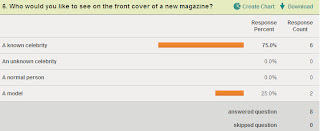All of the people that answered this question said that they were interested in fashion magazines, 6/8 people said that they were interested in gossip magazines, 1 /8 said that they liked sport magazines and another 1 person said they were interested in food magazines.
4 out of the 8 people that answered this question said that they normally buy a magazine every month, 2 of the 8 people said that they buy a magazine every week , another person said that they buy a magazine every 2 weeks & 1 more person said that they buy a magazine every 3 weeks.
7/8 people that answered this question said that they usually pay around £2-£3 for a magazine and 4/8 said that they would usually spend around £1-£2.
This question was multiple choice (multiple answer ) , 7/8 people would like to see more fashion in magazines, 5/8 people said that they would like to see more of healthy eating in magazines, 5 people said that they would want to see more gossip in magazines, 4/8 people said they would like to see more celebrities in magazines, 1 person said that they would like to see more of sport in magazine and 3 people chose other, which means they would like to see more of something else in magazines.
This question, like the previous was multiple choice (multiple answer), 6 people said that they have purchased OK! In the past, 4 people said that they have purchased Reveal in the past, 4 people said that they have purchased heat in the past, 5 people have brought Now in the past and 3 people said that they have purchased Vogue before.
6 out of the 8 people that answered this question said that they would like to see a known celebrity on the front cover of a new magazine, but the other 2 people said that they would like to see a model on the front cover of a new magazine.
6 out of the 8 people that answered this question said that they would like to see the new magazine being purchased once a week; the other 2 out of 8 people said that they would like to see the new magazine purchased monthly.
This question was multiple answer, 1 person said that they would like to see stationary being purchased with the new magazine another person said they would like to see stickers being purchased with it. 5 people said that they would like to see nail polish being purchased with this new magazine, 3 people said that they would want lipstick or lip gloss to be purchased with the magazine, and 4 people said that they would like something else to be purchased with this new magazine.







